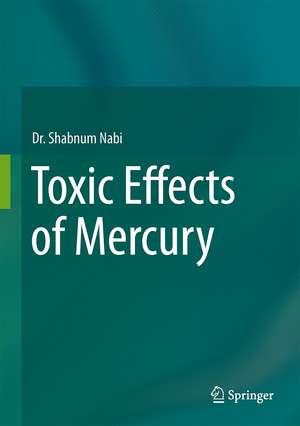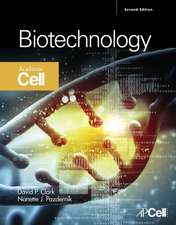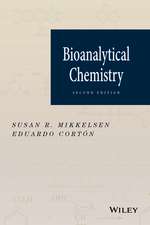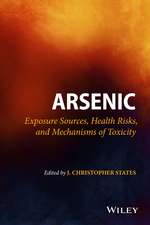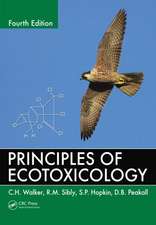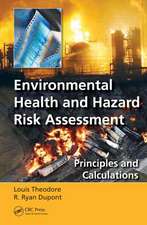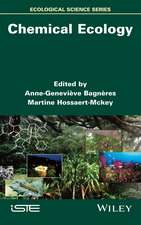Toxic Effects of Mercury
Autor Shabnum Nabien Limba Engleză Hardback – 13 aug 2014
This book will provide state-of-the-art information to the graduate students training in toxicology, risk assessors, researchers and medical providers at large. It is aimed to bring the readers updated information on contemporary issues associated with exposure to methylmercury, from its effects on stem cells and neurons to population studies. It is a valuable resource for individuals interested in the public health effects and regulation of mercury. The report provides an excellent example of theimplications of decisions in the risk assessment process for a larger audience and is written with the hope that the information will provide better understanding of the mercury problems which confront us.
| Toate formatele și edițiile | Preț | Express |
|---|---|---|
| Paperback (1) | 947.98 lei 6-8 săpt. | |
| Springer India – 22 sep 2016 | 947.98 lei 6-8 săpt. | |
| Hardback (1) | 955.40 lei 6-8 săpt. | |
| Springer India – 13 aug 2014 | 955.40 lei 6-8 săpt. |
Preț: 955.40 lei
Preț vechi: 1165.11 lei
-18% Nou
Puncte Express: 1433
Preț estimativ în valută:
182.87€ • 198.71$ • 153.71£
182.87€ • 198.71$ • 153.71£
Carte tipărită la comandă
Livrare economică 21 aprilie-05 mai
Preluare comenzi: 021 569.72.76
Specificații
ISBN-13: 9788132219217
ISBN-10: 813221921X
Pagini: 180
Ilustrații: XXV, 268 p. 63 illus., 48 illus. in color.
Dimensiuni: 178 x 254 x 22 mm
Greutate: 0.73 kg
Ediția:2014
Editura: Springer India
Colecția Springer
Locul publicării:New Delhi, India
ISBN-10: 813221921X
Pagini: 180
Ilustrații: XXV, 268 p. 63 illus., 48 illus. in color.
Dimensiuni: 178 x 254 x 22 mm
Greutate: 0.73 kg
Ediția:2014
Editura: Springer India
Colecția Springer
Locul publicării:New Delhi, India
Public țintă
ResearchCuprins
Unit I: History of Mercury Toxicology.- Chapter 1: Occurrence and Properties.- Chapter 2: Estimated Applications.- Chapter 3: Distribution, Metabolism and Excretion.- Chapter 4: Toxicological Effects and Remedy.- Chapter 5: Antioxidant Drugs Mitigating Toxicity.- Chapter 6: Mercury and Cognition.- Unit Ii: Review of Literature.- Chapter 7: Exposure, Sources and Intoxication.- Chapter 8: Methylmercury and Oxidative Stress.- Unit Iii: Toxicity Evaluation Methodology.- Chapter 9: Materials and Analytical Procedures.- Chapter 10: Biochemical Estimation Techniques.- Chapter 11: Neurobehavioral Assessment Models.- Unit Iv: Free Radical Stress: Chapter 12: Mercury as a Source of Reactive Oxygen Species.- Chapter 13: Promotion of Peroxidation and Hydroperoxidation of Lipids.- Chapter 14: Summary and Conclusions.- Unit V: Toxic Responses of Antioxidant Defense System.- Chapter 15: Endogenous Antioxidants.- Chapter 16: Deregulation of Antioxidant Activities.- Unit Vi: Systemic Toxicology.- Chapter 17: Toxic Responses of the Plasma Total Antioxidant Power (Frap).- Chapter 18: Toxic Responses of the Plasma Xanthine Oxidase (Xo).- Chapter 19: Toxic Responses of the Plasma Glutathione Peroxidase (Gshpx).- Unit Vii: Neurobehavioral Toxicology: Chapter 20: Impairment of Emotional Behavior.- Chapter 21: Connection to Anxiolytic Behavior and Reflex Movements.- Chapter 22: Effects on Depression Like Behavior.- Unit Viii: Genetic Toxicology.-Chapter 23: Micronucleus Test (Mnt).- Chapter 24: Chromosomal Aberrations.- Unit Ix: Methylmercury Toxicity and Linked Diseases.- Chapter 25: Methylmercury and Minamata Disease.- Chapter: Methylmercury and Alzheimer’s Disease.- Chapter 27: Methylmercury and Parkinson’s Disease.- Chapter 28: Methylmercury and Thimerosal.- Chapter 29: Thimerosal l and Occurrence of Autism.- Chapter 30: Methylmercury and Lupus.- Chapter 31: Methylmercury and Amyotrophic Lateral Sclerosis.- Chapter 32: Mercury Pollution prevention.
Notă biografică
Dr. Shabnum has obtained her Ph.D. degree in Zoology (Cytogenetics) in 2012. The prime focus of her research has been Neurotoxicity, Genotoxicity and Neurobehavioral toxicity. She is the author of several papers published in reputed and peer-reviewed journals. Besides having National and International conferences to her credit, she is the member of Zoological Society of India. She has participated as a young scientist in a congregation of Nobel Prize Winners at IIIT Allahabad. She has also availed a Research Fellowship (J.R.F.) from University Grants Commission (U.G.C.), New Delhi.
Textul de pe ultima copertă
Mercury is widespread in our environment. Methylmercury, an organic form of mercury, can accumulate in the aquatic food chain and lead to high concentrations in predatory fish. When consumed by humans, contaminated fish represent a public health risk. Toxic Effects of Mercury intends to facilitate among its readers the understanding of the importance of mercury pollution in the environment and the health consequences associated with exposure to this metal. The knowledge on methylmercury (MeHg) toxicity collected over the years is undoubtedly robust creating an impression all that is to be learnt about this metal has already been accomplished. However, in large measure, past knowledge has merely laid the ground for interesting questions that have yet to be fully addressed and concepts have yet to be deciphered. One of my major goals was to make a valiant attempt to include state-of-the-art information on the mechanisms of mercury toxicity, describing its effects on cultured cellular systems as well as in whole living organisms, starting from the lessons learned from the tragic events in Minamata Bay, Japan. A special focus of the book is on the neurotoxic effects of MeHg. An understanding at the cellular level is necessary to gather information on the structural and functional alterations induced by MeHg and how they possibly become unmasked and evident at the behavioral level, 32 chapters of the book have been organised having these considerations in mind.
This book will provide state-of-the-art information to the graduate students training in toxicology, risk assessors, researchers and medical providers at large. It is aimed to bring the readers updated information on contemporary issues associated with exposure to methylmercury, from its effects on stem cells and neurons to population studies. It is a valuable resource for individuals interested in the public health effects and regulation of mercury. The report provides an excellent example of the implications of decisions in the risk assessment process for a larger audience and is written with the hope that the information will provide better understanding of the mercury problems which confront us.
This book will provide state-of-the-art information to the graduate students training in toxicology, risk assessors, researchers and medical providers at large. It is aimed to bring the readers updated information on contemporary issues associated with exposure to methylmercury, from its effects on stem cells and neurons to population studies. It is a valuable resource for individuals interested in the public health effects and regulation of mercury. The report provides an excellent example of the implications of decisions in the risk assessment process for a larger audience and is written with the hope that the information will provide better understanding of the mercury problems which confront us.
Caracteristici
The book has relevance in present times due to a large population exposed to mercury toxicity The book gives a detailed and comprehensive account of neurological effects of mercury poisoning The book also explores the defense mechanism of the body in response to mercury toxicity This study focused primarily on two antioxidants: 1) Vitamin- E and 2) Acetyl-L-Carnitine and their intervention in methylmercury poisoning by improving the mobilization and excretion of this metal Includes supplementary material: sn.pub/extras
